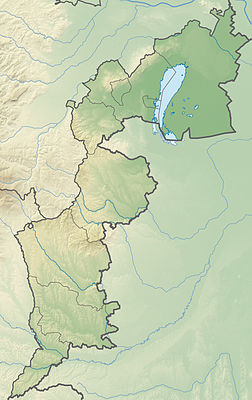Schlaining Castle
| Schlaining Castle | ||
|---|---|---|
|
Schlaining Castle 2010 |
||
| Alternative name (s): | castrum Zloynuk | |
| Conservation status: | Received or received substantial parts | |
| Standing position : | Count | |
| Place: | Stadtschlaining | |
| Geographical location | 47 ° 19 '20 " N , 16 ° 16' 49" E | |
|
|
||
The Burg Schlaining (ung. Szalónak vár ) is located on the outskirts of Stadtschlaining in Burgenland .
location
The castle was originally located on an important traffic artery that led in a north-south direction over the Bernstein Mountains . The trade routes that led from Steinamanger , Graz , Wiener Neustadt and Ödenburg through the area later crossed there .
history
The castle was mentioned in 1271 as castrum Zloynuk in a document from Ottokar Přemysl . It was given its current name in 1786 after some changes such as Sliunic, Zalonuk, Zolonak, Slany, Schläning.
In 1271 the castle was owned by the Güssing Counts and, after several changes of ownership, was in 1445 by King Friedrich III. pledged to the mercenary leader Andreas Baumkircher . After his execution in 1471, King Ferdinand gave the fallen fiefdom to Franz Batthyány . The last owner from this line, Ludwig Batthyány , was appointed the first Hungarian Prime Minister on March 17, 1848. After his execution on October 6, 1849, his property, including the castle, came into the possession of the Hungarian Chamber. In 1849 the railway pioneer Franz Schmidt bought the castle, in 1911 the ownership changed to Demeter Salesky, who had to hand over the castle to the Hungarian Hermesbank after the First World War .
From 1957 to 1980 the castle belonged to the former Austrian Federal Minister Udo Illig . Since then it has belonged to the Province of Burgenland and is used as a conference center by the Austrian Study Center for Peace and Conflict Resolution (ÖSFK), which is also based there.
The 2nd International Conference of Peace Museums took place there in 1992, and in 2000 the European Peace Museum was set up at the castle by the ÖSFK . In 2018 the 32nd annual conference of the future workshops took place there with guests from Germany, Austria, Spain, Syria and Hungary: "Building bridges, creating peace - Against the division of society" was the focus.
The castle
The brick castle bridge leads over the moat to the main portal. The second castle gate leads to the large castle courtyard, in which five crown-shaped chestnuts were planted in honor of Empress Elisabeth ("Sisi") .
The castle chapel is equipped with a baroque interior design, a high altar from the mid-18th century, a way of the cross and three depictions from the life of Jesus. A table organ from the 17th century stands on the mansion's gallery.
The knight's hall is dominated by a mighty barrel vault as well as secular frescoes , which are among the oldest in Burgenland.
Protected bats live in the square tower, and in the round tower you can enjoy a beautiful panoramic view.
European Museum for Peace
The Peace Museum presents a permanent exhibition on the history of war and conflict in the castle cellar, in the “Black Courtyard” and on the first and second floors of the east wing. The museum's motto is the noble word "If you want peace, you must prepare peace."
The exhibition is divided into four sections: peace, conflict, violence and the environment . In addition to the permanent exhibition, various special exhibitions are held in the "Angel Halls".
The museum is a member of the International Network of Museums for Peace , and the second such institution after the First Austrian Peace Museum in Wolfsegg am Hausruck (founded in 1993).
L. Toth Collection
Ludwig Toth's folklore collection of the Oberwart district is on display on the third floor. This is the most extensive of its kind in Burgenland.
"Granarium" conference center
In 1986, a conference center with seminar rooms and a hall for around 300 people was built on the ruins of the outer bastion and the granary .
See also
Web links
- Entry via Burg Schlaining to Burgen-Austria
- Entry on Schlaining Castle in the Austria Forum (in the Heimatlexikon)
- Entry on The utopia of a world without war in the Austria Forum (in the collection of essays)
- European Peace Museum
- Schlaining Castle , mamilade.at
Individual evidence
- ↑ a b c d e f g h i Friedensburg Schlaining, European Museum for Peace (ed.): Austrian Study Center for Peace and Conflict Resolution - ÖSFK Stadtschlaining (prospectus without date)
- ^ Peter van den Dungen (Department of Peace Studies, University of Bradford, Bradford, UK): Preventing Catastrophe: The World's First Peace Museum . In: 立命 館 大学 - Ritsumeikan University (Ed.): 立命 館 国際 研究 (Ritsumeikan Annual Review of International Studies) . tape 18 , March 2006, p. 449–462 (23–36) (English, online [PDF; accessed on May 15, 2018]).
- ↑ Gerald Mader: European Museum for Peace at Schlaining Castle . In: International Cultural Studies. Institute for Research and Promotion of Austrian and International Literature Processes (INST)
- ↑ Gerald Mader: Intro ( memento of the original from June 24, 2010 in the Internet Archive ) Info: The archive link was inserted automatically and has not yet been checked. Please check the original and archive link according to the instructions and then remove this notice. , friedensmuseum.at
- ^ International Network of Museums for Peace


